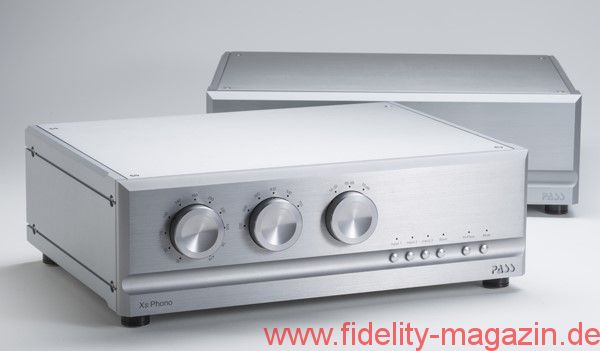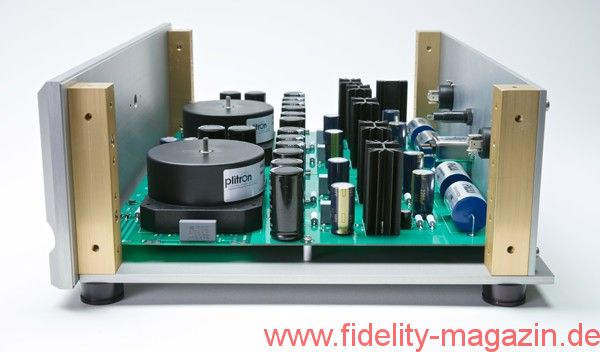Pass Labs Delivering New Xs Phono Preamplifier
What Could Make a Phono Stage Worth $45,000?
When an audio company proposes to sell a phono stage with a Manufacturer’s Suggested Retail Price in the United States of $45,000, a decent respect for the opinions of mankind would seem to require that they explain and justify such a remarkable price.
Pass Laboratories is pleased to comply…
Pass Labs’ Xs Phono Preamplifier is a dual-chassis, completely dual-mono phono stage (even the outboard power supply is entirely dual-mono, after the single power cord from the wall outlet), designed and built without consideration of expense. NOT because Pass Labs’ engineers disdain affordability. Rather, because Pass Labs’ engineers wanted to build they best-sounding phono stage they possibly could.
So, in the first instance, the Xs Phono was an in-house design exercise, developed over the course of two+ years. Pass Labs’ design team aimed at creating a new reference for what is possible in the demanding discipline of phono-cartridge pre-amplification, where the signals requiring amplification and RIAA compensation are as small as millionths of a Volt.
Lead designer Wayne Colburn commented, “We tend to do well with products that we want for ourselves. Some of it is purely for us to have a reference.” The Xs Phono improves upon Pass Labs’ XP-25 phono stage (US MSRP $10,600) in nearly every way.
Improved shielding (resulting in lower noise), more accurate RIAA compensation, and the use of custom-made capacitors and shock-mounted, gold-clad custom ceramic circuit boards designed for RF applications all contribute to moving the Xs Phono up “into a different league—lower noise, better dynamics, all those things” says Colburn. “It’s a synergy of all the parts.”
The counter-intuitive feature that accounts for most of the Xs Phono’s cost increment over the Pass XP-25 came about only through extensive listening tests. But, first, some necessary background.
One “cultural” aspect that sets Pass Labs apart is its ongoing close communication with longtime “Golden Ear” customers. That communication provides important insights into customers’ wants and needs.
That’s how the Xs Phono’s design team knew that many of the customers for a reference or “statement” phono stage owned more than one turntable, or had more than one tone arm on their turntable. So, from the outset, the design brief for the Xs Phono included inputs for three phono cartridges.
The problem: extensive listening tests revealed there was no method of switching among three pairs of inputs that did not degrade the sound, when compared to direct connections. Confronted with this challenge, Pass Labs’ design team decided that each of the Xs Phono three pairs of inputs had to have its own separate, directly connected stereo phono stage. There are no switches or relays in the signal paths to the hugely important first amplification stages.
The result is that the Xs Phono (including its dual-mono power supply) contains 13 circuit boards. The Xs Phono is, in effect, three separate state-of-the-art stereo phono stages housed in one chassis. Says Colburn, “It seems crazy, but… the fact of the matter was, it sounded best that way. If you want to do the best you can, that is the way to do it.” That feature accounts for a large portion of the Xs Phono’s price.
While the Xs Phono obviously is not for everybody, its creators did discover there was pent-up demand for a no-compromise phono stage from Pass Labs. Xs Phonos have already been sold to customers who wanted a reference-quality phono stage, and they wanted it only from Pass Labs.
One enthralled client said, “It changes the way you listen to vinyl.” Which only makes sense. A no-compromise phono stage of the Xs Phono’s capabilities allows dedicated vinyl lovers to get the most out of the investments they have already made in the rest of their stereo equipment.
Technical Details…
Pass Labs’ Xs Phono Dual-Chassis Phonostage is powered by its dual-mono outboard power supply, the chassis of which has a form factor identical to the Xs Phono’s control chassis. The power-cord inlet connects to two totally independent left and right power supplies, each with its own transformer, filtering, and regulation. The control section has its own regulated power supply as well.
The power-supply chassis connects to the Xs Phono’s control chassis by means of two power cables fitted with PowerCON locking connectors. The power supply’s front panel has an LED indicating operation. In addition to the PowerCON connectors, the power supply chassis rear panel has an IEC inlet and a fuse receptacle. The power supply has no on-off or Standby switch, in that the Xs Phono is designed to remain powered-up at all times. At idle, the Xs Phono’s power consumption is 75 Watts.
The Xs Phono’s control chassis front panel’s layout is graceful and intuitive. Three large knobs control resistive loading, capacitive loading, and gain. Four small buttons provide for input selection, memory recall of settings for all three inputs, high-pass filter (rumble filter), and phono muting. Small blue LEDs around each of the large knobs indicate the settings for resistive loading (11 settings), capacitive loading (6 settings), and gain (3 settings). Each of the four small buttons for function selection has a single LED indicator light. Upon connecting the power supply, the Mute LED illuminates until housekeeping functions are completed.
The Xs Phono allows selection of resistive loading between 30 Ohms and 47k-Ohms; capacitive loading between 100pF and 750pF; and gain between 56dB and 76dB. The active value will always be indicated by an illuminated LED.
The selectable/defeatable high-pass filter or rumble filter imposes a -3dB roll off from 20Hz and below, to remove unwanted sub-sonic frequencies. When the high-pass filter is not engaged, the Xs Phono’s low frequency extension is to below 5Hz.
Unusually, the Xs Phono can output a single-ended (RCA) signal, a balanced (XLR) signal, or both at the same time. This permits, for example, providing a signal to an analog-to-digital converter or a digital-audio recorder at the same time as to a line stage or preamplifier.
Each of the Xs Phono three pairs of stereo inputs is served by a memory-recall function that saves the settings for resistance, capacitance, and gain. Once the optimal settings for a particular cartridge have been determined, pressing the “Save” button makes those settings the defaults for that input, always engaged upon the selection of that input.
However, when a certain recording’s peculiarities require some deviation from the normal settings, the front-panel controls are always active, so temporary adjustments as called for can be made without losing the saved settings.
The Xs Phono is not equipped with remote control, for the logical reasons that a listener has to get up to change the record anyway, and furthermore, in a design that was conceived as an all-out assault on the state of the art, convenience must give way to performance.
Conclusion
The counter-intuitive feature that accounts for most of the Xs Phono’s cost increment over the Pass XP-25 came about only through extensive listening tests. But, first, some necessary background.
The Xs Phono is a product of Pass Labs’ culture, heritage, and philosophy. The Pass Labs’ engineering team has been together for 25 years, while Nelson Pass has been an innovative force in audio-circuit design for 40 years. The Xs Phono is the sum of all that experience.
The Xs Phono is the most intensive design effort in Pass Labs’ 25-year history. Paradoxically for a company that prides itself on simplicity in design and execution, the Xs Phono’s 13 circuit boards contain approximately 1,500 electronic components — resistors, capacitors, diodes, and special Toshiba low-noise Field Effect Transistors (FETs). The dual-mono architecture that starts right after the power-cord inlet and which continues through to the output connectors guarantees the smallest possible amounts of noise and interchannel crosstalk.
The fact of the matter is that such levels of complexity, redundancy, and overkill were necessary to achieve the design goal of creating a new Reference for what is possible in phonograph-record playback. The result is listening to music that emerges from a quieter background and which blooms into a richer, more precise soundstage.
Says lead designer Wayne Colburn: “You are transported into the musical experience. You find yourself just sitting there and enjoying the music. It’s about the musical experience, as opposed to collecting equipment.”
Wayne Colburn concludes, “Pass Labs has been around a long time. We stand behind our products. We try to make good products, and especially, to make reliable products. That is important when you are shipping all over the world. We really take care of our customers.”
About Pass Labs
Founded in 1991 by legendary audio designer Nelson Pass, Pass Laboratories, Inc. markets its unique amplifiers and preamplifiers. The company is based in Auburn, California, and is universally regarded as one of the most innovative audio brands in the world. Its critically acclaimed Aleph, X and XA-Series products have won numerous awards, and Founder Nelson Pass holds numerous audio patents. His achievements include developing the first dynamically biased Class-A amplifier circuit, developing a fully cascode audio power amplifier, and developing the Stasis amplifier in 1977. He helped popularize solid-state, single-ended Class-A power amplifiers, and developed the very successful Aleph series of products, and the Super-Symmetry™ circuit, which achieves exceptionally low distortion and noise levels.




